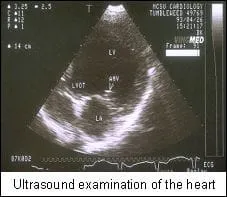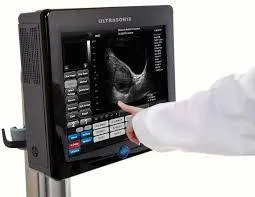What is an ultrasound?
An ultrasound examination, also known as ultrasonography, is a non-invasive imaging technique that allows internal body structures to be seen by recording echoes or reflections of ultrasonic waves. Unlike x-rays, which are potentially dangerous, ultrasound waves are considered to be safe.
Ultrasound equipment directs a narrow beam of high frequency sound waves into the area of interest. The sound waves may be transmitted through, reflected or absorbed by the tissues that they encounter.
"Ultrasound waves that are reflected will return as "echoes" to the probe, and are converted into an image."
The ultrasound waves that are reflected will return as "echoes" to the probe, and are converted into an image that is displayed on the monitor, giving a 2-dimensional "picture" of the tissues under examination.
The technique is invaluable for the examination of internal organs and was first used in veterinary medicine for pregnancy diagnosis. However, the technique is also extremely useful in evaluating heart conditions and identifying changes in abdominal organs. Ultrasonography is very useful in the diagnosis of cysts and tumors.
Does the technique have any drawbacks?
"Ultrasound waves will not pass through air."
Ultrasound examinations are of little value in examining organs that contain air.Ultrasound waves will not pass through air and therefore it cannot be used to examine normal lungs. Bone also stops ultrasound waves, so the brain and spinal cord are unable to be seen with an ultrasound study,and obviously, bones cannot be examined.
Are there different forms of ultrasound?

Depending on the images produced, ultrasound can take various forms. In veterinary work B-mode (brightness-mode) ultrasound, more commonly called 2-dimensional ultrasound is the most common form. This gives a two dimensional picture of the organ scanned. This is the type of ultrasound that is used to examine abdominal structures, perform pregnancy diagnosis, evaluate cardiac function and examine the eyes for certain eye diseases.
"Examine abdominal structures, perform pregnancy diagnosis, evaluate cardiac function and examine the eyes."
M-mode (motion-mode) is a type of B-mode in which a tracing of the motion of the structure being scanned is displayed. A combination of M-mode and2-dimensional ultrasound are used for examining the heart walls,chambers and valves to evaluate cardiac function. Cardiac ultrasonography is usually referred to as echocardiography. Doppler ultrasound is a specialized form of cardiac ultrasound in which the direction and speed of blood flow in the heart and blood vessels can be measured. Color-flow Doppler technology makes it even easier to observe the flow of blood through the heart and important blood vessels.
Will my dog have to have an anesthetic?
"Anesthesia is not usually needed... the technique is totally painless."
Anesthesia is not usually needed for most ultrasound examinations, unless biopsies are to be taken. The technique is totally painless and most dogs will lie comfortably while the scan is being performed. Occasionally, if the dog is very frightened or fractious, a sedative may be necessary.
Is it necessary to shave my dog's fur?
In most cases, the fur must be shaved to perform an ultrasound examination. Since ultrasound waves are not transmitted through air, it is imperative that the hand-held probe makes complete contact with the skin. In some cases, such as pregnancy diagnosis, it may be possible to get adequate images by moistening the hair with rubbing alcohol and applying a copious amount of water-soluble ultrasound gel.
"Ultrasound images will be of better quality if the area to be examined is shaved."
However, in all cases, the ultrasound images will be of better quality if the area to be examined is shaved.
When will I know the results of the examination?
Since an ultrasound study is performed in real time, the results of what is seen are known immediately. In some cases, the ultrasound images may be sent to a veterinary radiologist for further consultation. When this occurs, the final report may not be available for a few days
Is the technique affordable?
Although the initial cost of a scan may seem high, it has to be equated with the high cost of the equipment, the fact that specialized training is required in order to interpret the images, and a significant amount of time is involved in carrying out the examination. Its usefulness for pregnancy diagnosis, evaluation of the internal organs, assessment of heart function, and evaluation of certain eye diseases, make it an invaluable, non-invasive diagnostic tool to help protect to your pet's well-being.


